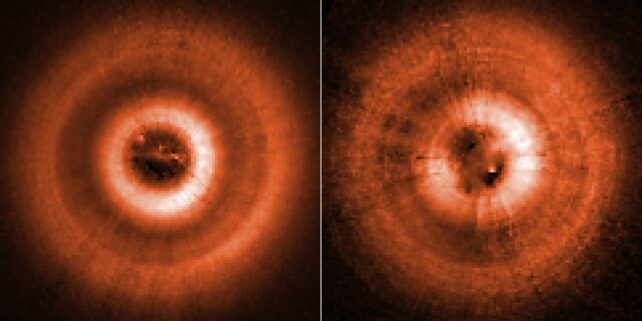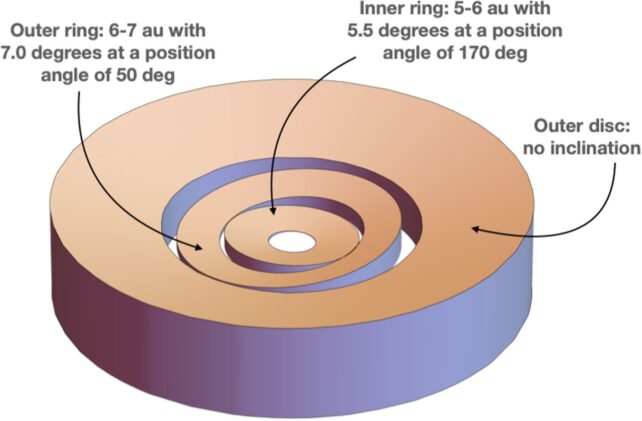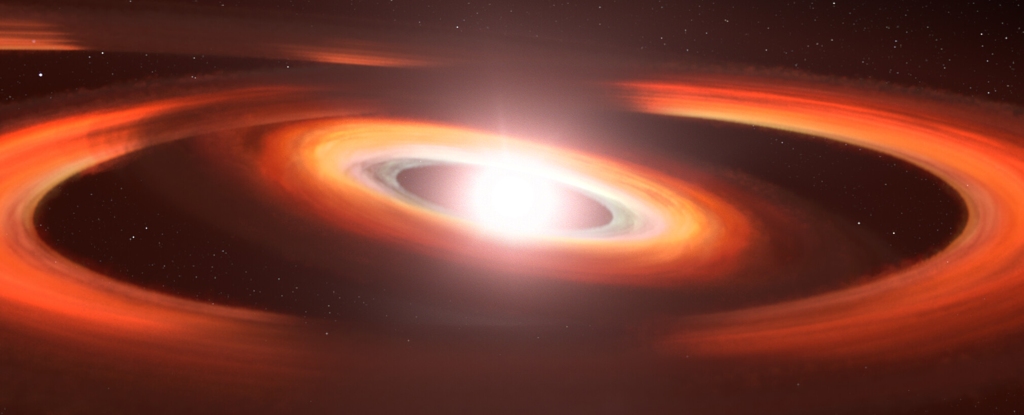Products You May Like
Shadows flickering across the dust roiling around a newborn star have revealed a rare glimpse of how the Solar System may have formed billions of years ago.
Changing light around a star named TW Hydrae suggests that the giant disks of material circling the star are off-kilter, orbiting at slightly different angles of inclination.
New signals suggest that there are three such wobbly disks – and their off-kilter alignment suggests the presence of multiple baby planets forming, their gravity tugging at the disks and pulling them askew.
“We’ve never really seen this before on a protoplanetary disk. It makes the system much more complex than we originally thought,” says astronomer John Debes of AURA for ESA and the Space Telescope Science Institute.
TW Hydrae has been of particular interest to planetary scientists for years. It’s only about 8 million years old. That’s very young for a star; the Sun, for comparison’s sake, is about 4.6 billion years old. It’s so young that it hasn’t started burning hydrogen in its core yet.
It’s still gaining mass and contracting down as it does so since gravity binds the star more closely as it grows. It’s about 60 percent of the Sun’s mass but has a slightly larger radius than the Sun. Indeed, TW Hydrae is thought to look a lot like the Sun did when it was a newborn.

As stars form, they slurp up dust and gas from the space around them. This material arranges into a disk that swirls around the star, feeding onto it from the inner rim. It’s from this disk that planets are born. Bits of material clump together, forming larger and larger clumps that collide with each other to grow planets.
Because they were born from a more-or-less flat disk, these planets orbit the star in a more-or-less flat plane around the star once everything is fully formed.
TW Hydrae is oriented in such a way that we can see this protoplanetary disk face-on. And since it’s only around 200 light-years away, we have front-row seats to a planetary construction site that seems very similar to our home system, one that could offer insights into how the Solar System was born.
Back in 2017, astronomers analyzing Hubble images spotted a shadow sweeping around the disk of TW Hydrae, completing a clockwise rotation every 16 years. At that time, they thought the shadow might be evidence of an unseen baby planet coming together from material in the disk and causing parts of the disk to orbit at slightly different planes.
In 2021, astronomers turned Hubble back to TW Hydrae for more observations. And this is where things got a little hinky.
“We found out that the shadow had done something completely different,” Debes says.
“When I first looked at the data, I thought something had gone wrong with the observation because it wasn’t what I was expecting. I was flummoxed at first, and all my collaborators were like: what is going on? We really had to scratch our heads, and it took us a while to actually figure out an explanation.”
The team devised some potential solutions and conducted extensive modeling to see if they could figure out what was causing the strange change in the shadow. The results showed that the most likely explanation is not just one but two wobbly disks casting shadows on the third outer disk – hinting at the presence of a second baby planet.
“The two planets have to be fairly close to each other,” Debes explains. “If one was moving much faster than the other, this would have been noticed in earlier observations. It’s like two racing cars that are close to each other, but one slowly overtakes and laps the other.”

The data suggest that the first disk is between 5 and 6 astronomical units from TW Hydrae, and the second is between 6 and 7 astronomical units. Jupiter, for context, orbits the Sun at a distance of 5.2 astronomical units, so that’s pretty consistent with Solar System architecture.
As they orbit, their gravitational interactions cause the disks to incline slightly with respect to each other, producing shadows that dim the reaches of the disk more distant from the star. The depths of the shadows suggest orbital inclinations of 5 to 7 degrees relative to the outer disk.
And this, too, is consistent with the Solar System. Although the planets here are mostly clustered around a flat plane, their orbital inclinations vary by up to 7 degrees (that’s Mercury), or 17 if you count Pluto. This means that TW Hydrae could be offering us a window into how the Solar System’s orbital inclinations got to be the way they are.
There is no doubt that future observations of this fascinating star and its baby planetary system are on the cards. Perhaps with more powerful instruments, we might be able to find even more newly forming worlds.
The research has been published in The Astrophysical Journal.
